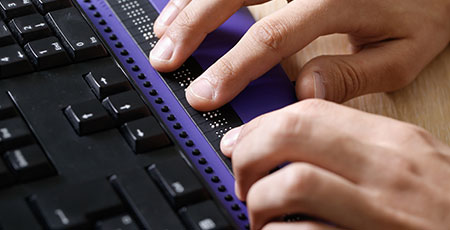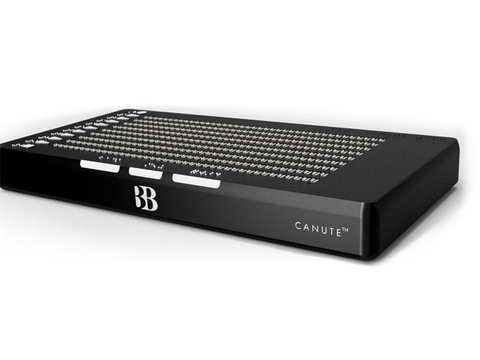Braille Displays and Notetakers: Must-Have Tools for Learning and Work
Empowering Freedom With Assistive Innovation for the Blind
The integration of assistive technology right into the lives of people with aesthetic problems represents a significant innovation in promoting freedom and self-sufficiency. From ingenious display readers to sophisticated smart walking canes, these devices not just boost day-to-day navigation and interaction however likewise equip customers to involve meaningfully in different aspects of life. As we explore the myriad advantages and real-world applications of these technologies, it comes to be critical to take a look at the hidden elements that add to their efficiency and the possibility for future developments in this important area.
Summary of Assistive Modern Technology

The development of assistive technology is grounded in principles of inclusivity and empowerment. Innovations in software application, hardware, and sensory enhancements offer users with options tailored to their particular requirements. From display visitors that transform text to speech, to tactile tools that share details with touch, these tools transform the way people involve with their surroundings.
Along with useful applications, assistive technology cultivates better social addition and involvement in various fields, consisting of education and work (AI-powered visual aids). As research study and development proceed to develop, the possibility for assistive innovation to even more boost the lives of visually damaged individuals continues to be appealing, paving the means for a much more fair society where every person can prosper
Types of Assistive Tools
A variety of assistive tools have arised to support individuals with aesthetic disabilities, each made to satisfy details requirements and boost daily performance. These devices range from low-tech remedies to state-of-the-art innovations, offering varied options for individuals.
Low-tech tools include magnifiers and large-print materials that aid in reading and writing. Braille tools, such as Braille slates and stylus pens, enable responsive analysis and communication. Orientation and wheelchair help, like white canes, assist customers browse their environment safely.
On the higher end of the spectrum, digital zoom systems and screen visitors offer considerable support. Electronic magnifiers enable users to enlarge text and photos on screens, while screen visitors transform electronic web content into synthesized speech, assisting in accessibility to information on computers and smartphones.
Mobile phone applications likewise play a crucial role, offering functions like text recognition and navigation support. Wearable innovation, such as clever glasses outfitted with increased fact, is arising as an encouraging device to boost situational recognition.
Advantages of Assistive Modern Technology
The assimilation of assistive modern technology dramatically boosts the top quality of life for people with visual disabilities. These technologies empower users by promoting independence, enabling them to browse their settings extra properly and execute everyday tasks with greater convenience. For example, display viewers and magnifying software program enable individuals to accessibility digital details, cultivating educational and professional chances that may have previously been out of reach.
Moreover, assistive devices such as smart canes and GPS applications offer real-time navigating help, boosting wheelchair and safety and security. This raised autonomy not only improves self-worth yet also urges social involvement, allowing individuals to participate even more fully in their neighborhoods.
Assistive innovation additionally assists in communication, assisting users connect with others with voice recognition and text-to-speech applications. This ability is essential for preserving partnerships and accessing critical info.
Furthermore, the personalization options readily available with many assistive technologies make certain that customers can tailor tools to their specific demands, additionally boosting functionality and efficiency. On the whole, the advantages of assistive technology for individuals with aesthetic impairments are profound, promoting a more inclusive culture where every person can seek their goals and aspirations.
Instance Researches and Success Stories
Highlighting the transformative effect of assistive modern technology, various study highlight exactly how individuals with visual impairments have effectively integrated these tools into their day-to-days live. One engaging example entails an university student that made use of screen analysis software to browse on the internet sources and academic materials properly. This technology not only facilitated her education yet also enhanced her confidence in taking part in conversations and group tasks.
One more instance study includes a professional that employs a mobile phone application designed for navigation and things recognition. By utilizing this app, he has regained freedom in both his individual and workplace, allowing him to commute separately and involve with colleagues much more properly.
Additionally, a senior citizen shared her experience with braille e-readers, which allowed her to access a large variety of literature and stay linked with her area through book clubs.
These success tales emphasize the essential function of assistive technology in fostering self-reliance, boosting lifestyle, and promoting social combination for people with visual disabilities (AI-powered visual aids). By welcoming these cutting-edge tools, individuals can overcome challenges and take possibilities that contribute to their individual and specialist fulfillment

Future Patterns in Assistive Modern Technology
Technology in assistive innovation is poised to redefine the landscape of support for individuals with visual disabilities. Emerging fads emphasize the combination of expert system (AI) and maker understanding, which enhance the performance of tools that assist with navigation and info access. AI-driven applications are currently capable of interpreting visual data in real-time, allowing individuals to involve with their atmosphere extra individually.
Additionally, the advancement of wearable technology is progressing swiftly. Smart glasses furnished with enhanced truth (AR) can provide audio summaries of environments, transforming how customers connect with public areas. These gadgets not only advertise autonomy but additionally foster social addition.
Additionally, the Net of Points (IoT) is making homes smarter, enabling smooth connection between assistive tools and daily appliances. This connection equips users by allowing computerized reactions and voice-activated controls customized to private demands.
Final Thought
To conclude, Braille displays and notetakers assistive modern technology plays a critical duty in equipping people with visual problems by improving their freedom and interaction with their environments. The diverse series of devices and applications available not just assists in navigating and communication yet also advertises social assimilation and chances for expert and individual growth. As advancements continue in this area, the potential for enhancing the top quality of life for those with visual disabilities will certainly expand, fostering higher freedom and empowerment.
